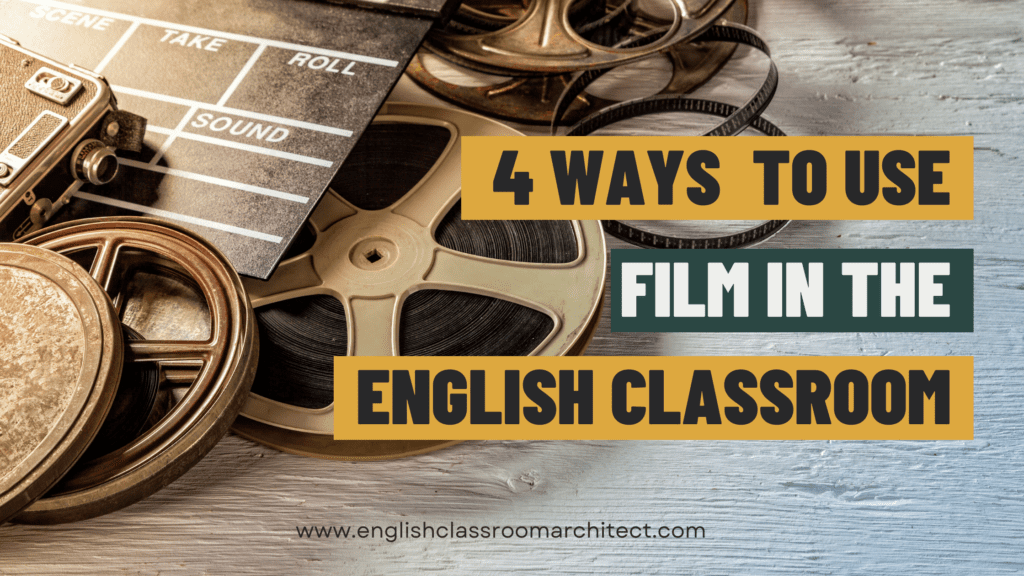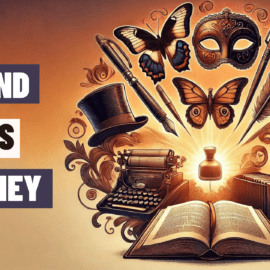They just don’t get it. Your students can’t form a mental picture because they feel the characters in the novel are too far removed from their lives. Using film in the classroom is a great way to increase engagement and understanding of course skills and concepts.

Benefits of Teaching with Films in the English classroom
As an English teacher, I hope I don’t have to really sell you on the benefits of teaching with films, but here are some talking points to bring back to your administrator if they don’t get it. Films give students an opportunity to explore critical perspectives in an accessible media. Great films explore complex themes students can draw from when discussing literature. Films can help students build context, helping them to better understand and connect with the texts we teach. Not only do films provide opportunity for connection and conceptual understanding, but movies also provide a medium for analysis in and of themselves. Films can be analyzed for craft as well as the critique of various cinematic aspects, such as cinematography, sound, and editing.
There are a variety of types of films that are useful tools for analysis in English classes.
Films as Context Building for Novel Units
I don’t know about you, but I am often surprised (even though at this point I shouldn’t be) that students don’t understand the differences of time periods. To them, the 1970s is the same as the 1950s. The 1800s are the same as the 1600s. Just nebulously “old.” Films as context provide two major benefits:
- Teaching with films give students visuals of the lives in different times and helps them better understand the progression of one time period to another.
- Filmmakers want us to connect to characters and storylines, so teaching with films can help students feel closer to the time period and make connections to their own lives. Teachers can capitalize on these connections as they move into novel units.
Film Adaptations as Pre-Reading and Supplements
Film adaptations of literature can be used before or after viewing, or as a means to truncate reading. I, like many other teachers, have had a lot of success showing adaptations of Shakespeare plays before reading. Since plays are written to be seen, I think this makes a ton of sense.
I’ve experimented with showing other literary adaptations before, and I’m not convinced this is the most effective use of a film. I recently tried showing The Great Gatsby before reading, and while I did find that students were very engaged in discussion during the unit, I am confident that many students did not dig into the actual text. I do think watching the film in place of a scene or chapter could work well, especially when discussing a director choice.
For instance, I’m a little obsessed with the scene in the 2015 adaptation where Nick and Gatsby ride into the city. The part I’m specifically referring to is when they pass by a car and the passengers are listening to Jay-Z. This, for me, is a great time to pause and discuss the significance of this choice. I love discussing modern self-made millionaires during a unit with Gatsby, and this is the perfect entry to looking at Jay-Z and Beyonce as a power couple. I ask students if the two typify the American Dream and how the image they portray compares to that of Jay Gatsby. There are so many interesting layers to discuss. This approach is a great introduction for teaching film analysis.
Films Related to Writing or the Writing Process
A lot of teachers I know use Dead Poets Society, and I agree it’s a great option for teaching with films, but one of my favorite films to use in the classroom related to writing and the writing process is the film Bright Star about the Romantic poet John Keats. I love Keats’ poetry, but I really enjoy his background. I think it’s interesting that he was trained to be a doctor, but gave that up to pursue life as a poet. I think Keats’ poetry draws on science, making it appealing to all types of student academic interests.
It’s a good draw for students in that way, but it also points to an opportunity to discuss life paths and that just because one expects to live a certain way that might not be the right path. Bright Star takes place after Keats is in medical training and is mostly about his life as a poet and his love for Fanny Brawne. This film gives students insight about the period and also gender expectations and norms. It makes a fantastic introduction for Frankenstein and primes students to apply feminist criticism to the text. In the past I’ve made popcorn and made a big deal about having a “day at the movies.” This film is a hit and the plot keeps students engaged.
Teaching with Pixar Shorts
I’m a big fan of teaching with Pixar shorts. These tend to be my go-tos because they are accessible to students, they can be great for teaching grammar, they tend to be full of symbolism, and often they can be used to start discussions about culture.
One of my favorite short films to teach is Bao. This Pixar short tells the story of an overprotective mother working through the pain of her son leaving home, told through her care of an anthropomorphized bun. This is a great film to use at the beginning of the year. I teach at a school with a high population of first generation immigrant students, and many of them can relate to the son and his struggle to reconcile the two cultures inside and outside his home. The cinematography is excellent, and full of opportunities for analysis. Looking at the music, film angles, symbols, and unusual story structure work well at the beginning of the year.
I find it’s a less imposing way to get an initial sense of the analysis skills present in the classroom than opening with a novel or even with short stories. I use Bao as an entry to a personal narrative unit at the beginning of the year around the concept of food and identity.
Conclusion
Teaching with movies is a fantastic way to scaffold, build skills, and deepen analysis. When used as part of a diverse curriculum, students are given another resource to bridge between texts and connect ideas throughout units. Movies are versatile and give students and teachers a change of pace and mental break between text heavy units. Exploring the different ways to incorporate films leads to a richer curriculum while also providing space for teachers to not have to be “on.”
Interested in purchasing ready-made resources? You may be interested in:
- Teaching the Research Process Using American Dream Films
- No Prep Film Lesson Plan: Mini Unit for the Film Quiz Show



